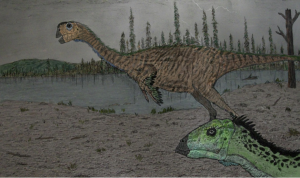The Gem State has more than gems (and potatoes). For the paleontologically inclined, Idaho also has an appreciable fossil record. Fossils range from the Precambrian to the Pleistocene, with fossils from all geological periods being reported. The only identifiable skeletal remains of dinosaurs known from Idaho are from the middle Cretaceous (latest Albian-Cenomanian stages, roughly 98 million years ago) Wayan Formation. The fossils are from a time interval that is poorly represented in the fossil record compared to the rich faunas of the Late Jurassic and Late Cretaceous of North America.
Judging from a relative abundance of partial skeletons (which may or may not be misleading about the actual paleoecology), the dominant animal at this time was the small herbivorous ornithopod dinosaur Oryctodromeus. This animal had the peculiar habit of digging burrows and spending time in them with its young, as demonstrated by the first specimens (an adult and 2 juveniles) discovered, which were found in a preserved burrow in coeval rocks in southwestern Montana. The next most abundant fossil are eggshell fragments and rare eggs of the egg Macroelongatoolithus. One complete egg measuring over 13 inches long as well as a partial egg of this type have been found, the shell microstructure suggests a large oviraptorid was laying these eggs. Frustratingly, remains of larger dinosaurs are extremely rare in the Wayan. The typical mid-Cretaceous fauna of large ankylosaurs, iguanodontids, and large theropods are mostly represented only by very rare isolated bones or teeth. This is unusual, and may reflect unique biases involved in preserving fossils in the Wayan paleoenvironments, with ongoing research hoping to address this question.
While heavy equipment and fossil preservation may not usually be congenial bedfellows, recent construction work at a site in eastern Idaho has revealed numerous fossils from these typically rare Wayan faunal elements. This construction site has turned into the most important fossil site in the Wayan Formation. What makes this site so important is that fact that it is producing remains of so many of those organisms that are not at all common anywhere else in the formation. These include teeth and bones from small dromaeosaurid theropods, medium-sized as yet unidentified theropods, ankylosaurs, larger as yet-unidentified dinosaurs, turtles, crocodylians, as well as some bones from Oryctodromeus. In over 11 years spent working in the Wayan, I could count on one hand the number of times I have found non-Oryctodromeusbones before this blessedly fossiliferous site was torn through by heavy equipment. Salvaging work is continuing at this site and will heavily contribute to a better overall picture of the Wayan Formation Fauna.
 |
|
Oryctodromeuscaudal (tail) vertebra in cross section at the mentioned construction site. Specimen recovered from lands administered by Caribou-Targhee National Forest.
|
 |
| Small dinosaur limb end in matrix block from the construction site. Specimen recovered from lands administered by Caribou-Targhee National Forest. |
 |
| Outcrops of fluvial sandstones and associated redbeds of the Wayan Formation. |
 |
| Oviraptorid (feathered fellow) and Oryctodromeus near a lake shore 98 million years ago in Idaho. Art by L. Krumenacker. |
 |
|
Poorly rendered Oryctodromeusnear a Wayan river channel, with an iguanodontid in the background. Artwork by L. Krumenacker.
|
![]() This work is licensed under a Creative Commons Attribution-NonCommercial-ShareAlike 4.0 International License.
This work is licensed under a Creative Commons Attribution-NonCommercial-ShareAlike 4.0 International License.
